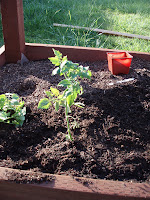Tomato Planting Guide
First lets understand some terminology, many have heard of indeterminate and determinate tomatoes. But do you know what that means? Determinate tomatoes varieties tend to reach a fixed height and ripen all their fruit in a very short time. Some examples include many of the paste varieties, “Ace”, “Celebrity”, and “Patio.”
Most of the tomato varieties grown in home gardens are indeterminate vining tomatoes. They will continue growing until they are killed by frost and keep setting fruit throughout the growing season. Some examples are “Beefsteak”, “Big Boy”, “Brandywine”, and “Early Girl”.
Heirloom and Hybrids are other words commonly spoken when discussing tomatoes and vegetables. Heirloom tomatoes are vegetables people had saved the seeds and replanted each spring continuing the line of the plant over many years. Heirlooms are openly pollinated vegetables, which means they can produce seeds that can produce the same tomato the following year. Openly pollinated also means they can cross breed with other tomatoes in the area making a different tomato from the resulting seed.
Plant breeders cross breed compatible types of plants in an effort to create a plant with the best features of both parents. These are called hybrids and many of our modern plants are the results of these crosses. In the agriculture industry farmers are looking for more disease resistance to protect their crops. As a result many hybrids are more disease resistant. But farmers are also looking for fruit that hold up better to shipping and look real good in the stores, at times this has come at the expense of taste. Ultimately the decision is yours.
Wait until Mother’s Day to plant your tomato plants outdoors. You can start your tomatoes indoors earlier, but resist the temptation to plant them outdoors earlier than Mother’s Day.
Plant your tomatoes in Gardner & Bloome Harvest Supreme, its 15% chicken manure and earth worm casting will provide enough fertilizer to get your plants off to a good start. After a month you will need to start a fertilizing routine. Tomatoes are hungry plants; use Gardner & Bloome Tomato Food for an organic choice. Now is a good time to add agricultural lime to your soil, this will help in preventing blossom end rot. Blossom end rot is the brown leathery spot on the bottom of the tomatoes that can form from lack of calcium.
Pick a very sunny location to plant your tomato. Pull or cut the leaves off the bottom 3rd of your tomato and plant it deep enough to bury that portion of the plant’s stalk.
Watering your tomatoes is very important and the amount of water will very based the plant’s location, weather temperature and humidity. If using a pot ensure there is plenty of drainage for your tomato. In the hottest weather you will most like have to water everyday. It is important to maintain a consistent soil moisture to prevent fruit problems. Consider adding a small deep watering stake to aid in putting water and fertilizer directly on the roots of the plant.
Consider planting marigolds around your vegetable garden to aid in keeping bugs off your plants. This technique will not stop all bugs, but it will add some visual interest to your vegetables.






No comments:
Post a Comment